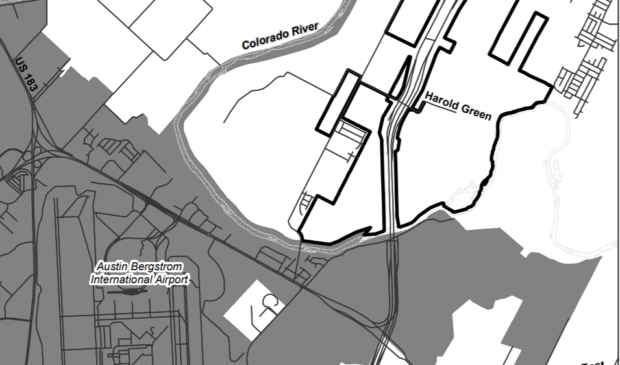Planning Commission recommends Austin Green PUD with a laundry list of amendments
Monday, March 2, 2020 by
Jessi Devenyns The Austin Green planned unit development, which is located just east of the Austin city limits on Harold Green Road, has now received two unanimous commission votes recommending that the 2,122-acre former sand and gravel mine receive PUD rezoning. On Feb. 25, the Planning Commission offered its seal of approval for the project with the caveat that Council considers the conditions outlined by the Environmental Commission and nine amendments brought forth by the Planning Commission.
Commissioner Conor Kenny brought 13 amendments to the Planning Commission, explaining that he had met with members of GroundWork Development to come to a consensus about how to further refine the proposed plan. “They’re trying to do something really innovative that we’ve never done before,” Kenny said. The amendments, he explained, are “just firming up and putting a commitment where there were aspirations.”
City staff and legal weighed in to indicate that several of the amendments were not viable and should be left out of any motion to recommend the PUD. Other amendments went above and beyond the entitlements that the developer asked for.
In one amendment, Commissioner Kenny proposed a 200-foot height limit for the central 207-acre MU1 zone of the PUD. GroundWork developers only requested 180 feet for that area. City staff recommended that the height in this part of the development remain limited to 120 feet.
Steven Spears, a principal with GroundWork Development, told the commission that having 180 feet of height was necessary to open up the possibilities for use in the central hub of the PUD. Additionally, he said the height had support from some Council members. “We also heard from multiple Council members to consider density – to go aggressive with density,” he said. Spears did not reject the idea of having additional height.
Wendy Rhoades with the Planning and Zoning Department argued that limiting the height to 120 feet is more in line with past recommendations from city staff. Capping the height of the building will also protect residents of the nearby Austin Colony from viewing skyscrapers from their backyards.
Spears noted that Austin Colony is 0.7 miles away. “We have no neighbors, so if we can’t have height here, where can we have it?” he said. The commission voted unanimously to support permitting a 200-foot height limit for the MU1 zone of the PUD.
To complete all of the construction and attain such a height, the developer will first have to reclaim the pitted landscape from mining operations and restore it to a buildable state. Spears estimated that doing so will require seven years, and he accordingly requested that staff extend the expiration of the preliminary plan from five years to seven. Commissioner Kenny reinforced Spears’ request, calling the site a “wasteland” and proposing an amendment to extend the expiration date for the preliminary plan to seven years. He said, “There’s not a high likelihood that they’ll be done in five years.”
Chair Fayez Kazi noted, “My sense is you might need much more than seven years.” Other commissioners pointed out that requesting a preliminary plan extension is a common occurrence at the Planning Commission and should not unnecessarily inhibit the progress of the project. The amendment to extend the validity of the preliminary plan failed.
A PUD is granted its zoning status because the development is superior to that which would otherwise be constructed using conventional zoning regulations, including the environmental components. The Austin Green PUD had an 8 on the Carbon Impact Checklist Tool and a 2-star rating from the Austin Energy Green Building Program. Yet Commissioner Todd Shaw felt that since this was a PUD, more could be done. “It’s our one opportunity to start preparing for the next 50 years. And we’ve got good tools in the tool kit, but we’re just not using them,” he said.
Spears explained that although the development team can reach for higher sustainability scores, doing so may push the price range of the buildings out of the realm of accessibility for average homebuyers.
The goal of Austin Green is to provide housing for a variety of income levels. Of the 12,800 planned residential units, 15 percent will be affordable at 60 percent of median family income for 40 years. Five percent of the units will be affordable at 80 percent of MFI for 99 years.
As for the level 8 score on the Carbon Impact Checklist Tool, Spears said he wished the development could have ranked higher. “The thing that was harming us most is that we are not in the Cap Metro service area,” he said.
Although Commissioner Shaw argued that in the long run, the pricier green construction will help residents offset their energy bills, he withdrew the motion.
To help get the development connected to Capital Metro service and offset some of the carbon impacts, the commission unanimously recommended that if it is legally feasible, the Municipal Utility District associated with the PUD will join the Capital Metro service district before certificates of occupancy are issued for more than 6,000 residential units.
With nine additional amendments attached to the PUD plan, the commission unanimously voted to recommend the project. Commissioner Claire Hempel recused herself and Commissioner James Shieh was absent.
Map courtesy of the city of Austin.
The Austin Monitor’s work is made possible by donations from the community. Though our reporting covers donors from time to time, we are careful to keep business and editorial efforts separate while maintaining transparency. A complete list of donors is available here, and our code of ethics is explained here.
You're a community leader
And we’re honored you look to us for serious, in-depth news. You know a strong community needs local and dedicated watchdog reporting. We’re here for you and that won’t change. Now will you take the powerful next step and support our nonprofit news organization?









